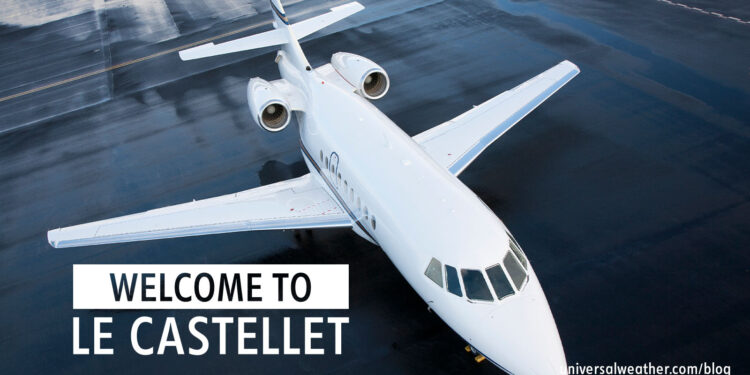Business Aircraft Ops to the French Riviera via Le Castellet: Part 1 – Airport Considerations

This is a post by author Isabelle Canton. Isabelle is the senior Universal Aviation representative – south of France for Universal Aviation France, which has aircraft ground handling facilities in Paris, Le Bourget and Le Castellet. Isabelle is an expert on business aircraft operations in southern France and can be contacted at cantonisabelle@universalaviation.aero.
This business aviation blog post is part of a series on operations to southern France.
Le Castellet (LFMQ) is a medieval village perched on a hill a few miles inland between Marseille and Toulon. For business aircraft operators planning missions to the French Riviera (Southern France), LFMQ is an ideal parking alternate when Nice (LFMN) and/or Cannes (LFMD) fill up during high season or busy local event times such as the Cannes Film Festival or Monaco Grand Prix. Aircraft parking always seems to be available at this location.
If considering using LFMQ, the following is an overview of what you need to know:
1. Pros and cons of Le Castellet
LFMQ is a privately owned airport of entry upon request, with 24/7 Customs, Immigration, and Quarantine (CIQ) available on prior notice. The airport hours are normally 0900-1800 local, but overtime can be arranged to be open at your requested time. Parking availability is plentiful for transient General Aviation (GA). High-quality crew accommodations are available close to the airfield. This airport has no scheduled commercial movements, and there are no peak hours of operation to consider. LFMQ offers full GA aircraft services. Towbars are not required at this location, and the airfield is CAT 5 fire-rated. If you wish to travel to Nice or Cannes, they are each a two-hour drive from LFMQ.
On the other hand, there are occasional CIQ availability issues at this location. And, with only a Non-Directional Beacon (NDB) approach, inclement weather and low cloud cover may cause you to divert – but not normally during summer months. There are mountains surrounding this airport, and it’s suggested – although not required – that the captain have landed here at least once during the day before making a night operation.
2. Curfews/limitations at LFMQ
Regular airport hours are 0900-1800 local, seven days a week. Airport overtime may be arranged with 24 hours’ notice, and there are charges for this. Stage 2 aircraft are accepted at LFMQ with no restrictions. LFMQ has only an NDB approach, but French Civil Aviation Authority is looking into upgrading the facility with a GPS approach.
3. Aircraft parking availability
Extended parking at LFMQ is not an issue, and the farthest parking spot is about a 10-minute walk to the terminal. Aircraft parking is separated by Maximum Takeoff Weight (MTOW). Aircraft of 15 metric tons MTOW or more are parked on the west side of the airport, while anything under 15 tons MTOW goes to the east side. Aircraft are not repositioned or relocated at this airport. LFMQ is a secure airfield, with adequate fencing, patrols, and video surveillance. No additional aircraft security is recommended. While parking areas at LFMQ are in good condition, the runway is older and slightly rough; however, it is due to be upgraded in the next few years. With a 5,741-foot runway, larger GA aircraft usually cannot depart with full fuel. Many operators opt to depart LFMQ, refuel, and complete EU departure CIQ at Shannon (EINN) – a U.S. Border Preclearance location – Prestwick (EGPK), or elsewhere.
4. Local area considerations
LFMQ is located a few miles from the village of Le Castellet and right next to the Formula 1 race circuit. This is a pleasant area for crews staying a few days – complete with cobblestone streets, ancient houses, fine restaurants, a large chateau, and nearby art galleries. Drive time is about 40 minutes to Marseille or Toulon and two hours to Nice. The coastal towns of Bandol and Sanary are just 20-30 minutes away, with 4- and 5-star crew hotel options available.
5. Hangar options
Five hangars are available for transient GA purposes at LFMQ. If you choose to use a hangar, you’ll need to request a license, for the duration of your stay, in order to gain access to your aircraft. During regular airport operating hours,crew have access to their parked or hangared aircraft, with permission from airport authorities.
6. Handling and services
Handling charges at LFMQ are separate from the airport parking fee. It’s best to pre-book all required aircraft services, and fuel uplifts at this location. There’s only one fuel truck at LFMQ, so it’s always best to provide desired fuel quantity well in advance.
7. In-flight catering
There are no in-flight caterers in the LFMQ area. It’s best to have catering delivered from LFMN, at a 200-Euro delivery charge, or to depart and pick up your catering at a fuel uplift point – such as EINN. Local hotels, including a nearby 5-star facility, are able to provide catering; however, because selections are limited, and portions are small, this option is not recommended.
Conclusion
LFMQ is a great airport for alternate parking when LFMN, LFMD, and LFML fill up. Operators appreciate the wide-open parking availability and privacy of this location. At LFMQ your aircraft can be hangared, it’s not visible to passers-by, and you will not be competing with scheduled commercial operations.
Universal is not associated in any way with the Formula One group of companies. F1, FORMULA ONE, FORMULA 1, FIA FORMULA ONE WORLD CHAMPIONSHIP, GRAND PRIX, and related marks are trademarks of Formula One Licensing B.V.
Questions?
If you have any questions about this blog article or would like assistance planning your next trip to Le Castellet or southern France, contact me at cantonisabelle@universalaviation.aero.
Stay tuned for Part 2, which covers more operational considerations for travel to southern France.




